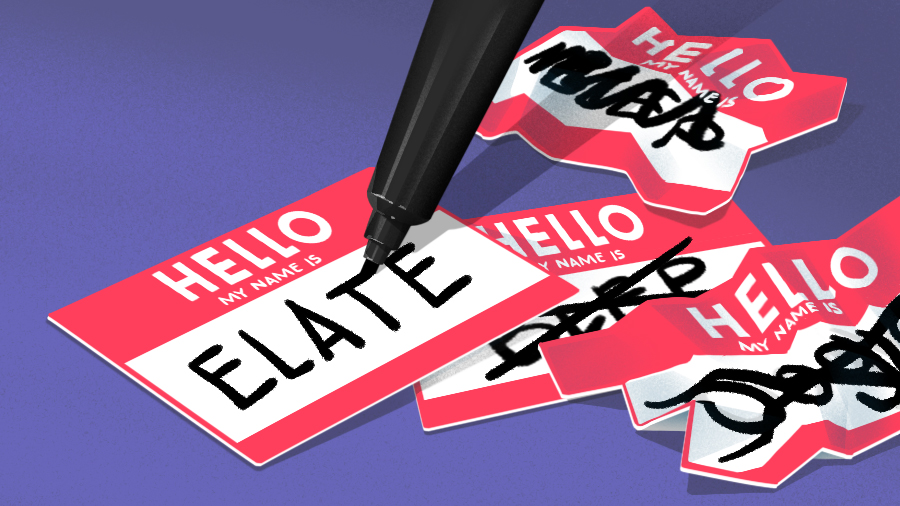From Weird To Boring: A Quick Trip Through The Recent History Of Startup Naming
Believe it or not, there was a time when reading through the names of the last 1,000 funded startups was kind of fun.
Founders named their companies after badgers, hippopotamuses and vegetables. Heck, you could name a company Coinburp 1 and still manage to secure seed funding.
Then someone hit the boring switch. As we’ve chronicled over recent years at Crunchbase News, startup naming choices have become noticeably duller these days.
To some extent, we can attribute the shift to a falling share of financing going to consumer-facing startups reliant on catchy brands. Imitation may also be a factor, as the most valuable unicorns today have serious-sounding names like OpenAI and Anthropic.
Now that we’re entrenched in the bland era, we thought it would offer a shot of entertainment value to take a look back at some of the sillier naming trends that have popped up over the past nine years that we’ve been chronicling such matters.
With that, here’s our ode to the top seven weird trends* of startup naming eras past and present.
No. 1 Weird name era: 2016-17
Featured trend: misspellings
There was a time when startups adapted to finding their dream name taken by going with a badly spelled version.
Eventually, favored techniques for doing so became pretty familiar. These included deleting the “i” and replacing it with a “y,” and changing a “c” to a “k.” With these approaches, startups were able to secure names that sounded like common words, even if they were hard to spell.
Standouts from the period include such monikers as Mylestone, Shyft Technologies, Kustomer and Kard. For other catchy typo names of this period, see our list here.
Weird name era: 2017-18
Featured trend: animal names
Animal names were in vogue for a while with startups developing both consumer-facing and backend technologies. The typical formula was also pretty straightforward: pick an animal and then add another descriptive word, as in MonkeyLearn or MortgageHippo.
Plus, with an animal name startups could also create a cute logo featuring the creature. Additionally, for legal risk-averse founders, it helped that hippos and squirrels weren’t going to sue for misappropriating their names.
For a sense of how animal names were proliferating at the time, we put together a list of funded startups from the period here.
Less weird name era: 2018-19
Featured trend: made-up words that sound real
There are more than 170,000 nonobsolete words in the English language, per the Oxford English Dictionary. Startups, however, are convinced we need more.
Hence, one of the more enduringly popular business naming practices is to come up with something that sounds like an actual word, even if it isn’t. We put together a list of examples of this naming style among seed-funded startups from this period.
It includes Trustology, which is building a platform to safeguard crypto assets, Invocable, a developer of voice design tools for Alexa apps, and Locomation, which focuses on autonomous trucking technology.
Less weird name era: 2019-2020
Featured trend: straightforward descriptions
Another popular branding approach was the straightforward description. This involved startups picking names that describe exactly what they do.
Such companies from this period include Grow Credit, a service for building credit histories, New Age Meats, a startup cultivating meat from animal cells, and The Browser Co., a software firm that designs and operates a specialized web browser.
In a naming expert’s opinion, there’s something to be said for these simpler, clearer names. They tend to be easier to remember than a made-up brand name, and everyone knows how to spell them.
Pandemic and post-pandemic name era: 2021-22
Naming trend: suffixes
Oftentimes, the only way to get a startup name that isn’t already taken is to add some sort of suffix to it.
As a result, over many years we saw the rise of startup names consisting of simple or catchy words with an “ly,” “ify” or some other suffix added. While not a new phenomenon, the practice seemed to catch on during this period, perhaps with founders contemplating the success of predecessors such as Shopify and Bitly.
To illustrate, we aggregated a sample list of seed-funded companies with suffix names from this period.
Boring name era: 2023-24
Naming trend: all the obvious names are taken
Today, there are millions of registered trademarks, meaning that most of the obvious, short, real-world names a founder might consider are already taken. That makes it a lot harder to come up with a name that cuts through the clutter.
To make matters more complicated, founders are also usually looking for a name that’s viable in multiple countries. And even if they find a humorous or quirky option that’s legally available, it might not resonate with some of their audience.
Looking at the most heavily funded startups of this period — a list that includes OpenAI, xAI, CoreWeave and Safe Superintelligence — none has a name one could describe as “fun.” It’s as if they had asked an AI chatbot for something that would score hefty investment but amuse no one.
The current era
Naming trend: do no harm
In a challenging seed-funding environment, one might expect founders to take a more cautious approach to selecting a name.
A perusal of top seed-funding recipients for this year shows this to be the case, with a paucity of silly-sounding names on the list.
That said, we do see some of our prior trends remain in effect, including use of animals (Project Orca), creative misspellings (Gruve) and popular first names (Theo), a practice that popped up in more than one prior survey.
As someone who spends a lot of time reading startup names, I’m hoping we’ll soon see a cyclical shift back to sillier stuff. Building a startup is hard work, after all, and it helps to add a little spirited fun to the mix. Of course, I’m not the one who has to convince investors to back my bizarrely named startup, so I’ll leave the actual decisionmaking to those who do.
Related reading:
- The Bizarre Naming Trends That Modern Startups Follow -2017
- Startups Are Still Making Weird Name Choices – 2018
- Startup Names May Have Passed Peak Weirdness – 2019
- Startup Names Are Still Getting Less Silly – 2020
- Startups Names Stay Strange As Bad Spelling Proliferates – 2022
- How Startups Stopped Being Fun – 2024
Illustration: Dom Guzman
Coinburp later changed its name to Ferriswheel and is apparently no longer in business.↩

Read More

Biotech Isn’t Partaking In The IPO Rebound
From Weird To Boring: A Quick Trip Through The Recent History Of Startup Naming
Believe it or not, there was a time when reading through the names of the last 1,000 funded startups was kind of fun.
Founders named their companies after badgers, hippopotamuses and vegetables. Heck, you could name a company Coinburp 1 and still manage to secure seed funding.
Then someone hit the boring switch. As we’ve chronicled over recent years at Crunchbase News, startup naming choices have become noticeably duller these days.
To some extent, we can attribute the shift to a falling share of financing going to consumer-facing startups reliant on catchy brands. Imitation may also be a factor, as the most valuable unicorns today have serious-sounding names like OpenAI and Anthropic.
Now that we’re entrenched in the bland era, we thought it would offer a shot of entertainment value to take a look back at some of the sillier naming trends that have popped up over the past nine years that we’ve been chronicling such matters.
With that, here’s our ode to the top seven weird trends* of startup naming eras past and present.
No. 1 Weird name era: 2016-17
Featured trend: misspellings
There was a time when startups adapted to finding their dream name taken by going with a badly spelled version.
Eventually, favored techniques for doing so became pretty familiar. These included deleting the “i” and replacing it with a “y,” and changing a “c” to a “k.” With these approaches, startups were able to secure names that sounded like common words, even if they were hard to spell.
Standouts from the period include such monikers as Mylestone, Shyft Technologies, Kustomer and Kard. For other catchy typo names of this period, see our list here.
Weird name era: 2017-18
Featured trend: animal names
Animal names were in vogue for a while with startups developing both consumer-facing and backend technologies. The typical formula was also pretty straightforward: pick an animal and then add another descriptive word, as in MonkeyLearn or MortgageHippo.
Plus, with an animal name startups could also create a cute logo featuring the creature. Additionally, for legal risk-averse founders, it helped that hippos and squirrels weren’t going to sue for misappropriating their names.
For a sense of how animal names were proliferating at the time, we put together a list of funded startups from the period here.
Less weird name era: 2018-19
Featured trend: made-up words that sound real
There are more than 170,000 nonobsolete words in the English language, per the Oxford English Dictionary. Startups, however, are convinced we need more.
Hence, one of the more enduringly popular business naming practices is to come up with something that sounds like an actual word, even if it isn’t. We put together a list of examples of this naming style among seed-funded startups from this period.
It includes Trustology, which is building a platform to safeguard crypto assets, Invocable, a developer of voice design tools for Alexa apps, and Locomation, which focuses on autonomous trucking technology.
Less weird name era: 2019-2020
Featured trend: straightforward descriptions
Another popular branding approach was the straightforward description. This involved startups picking names that describe exactly what they do.
Such companies from this period include Grow Credit, a service for building credit histories, New Age Meats, a startup cultivating meat from animal cells, and The Browser Co., a software firm that designs and operates a specialized web browser.
In a naming expert’s opinion, there’s something to be said for these simpler, clearer names. They tend to be easier to remember than a made-up brand name, and everyone knows how to spell them.
Pandemic and post-pandemic name era: 2021-22
Naming trend: suffixes
Oftentimes, the only way to get a startup name that isn’t already taken is to add some sort of suffix to it.
As a result, over many years we saw the rise of startup names consisting of simple or catchy words with an “ly,” “ify” or some other suffix added. While not a new phenomenon, the practice seemed to catch on during this period, perhaps with founders contemplating the success of predecessors such as Shopify and Bitly.
To illustrate, we aggregated a sample list of seed-funded companies with suffix names from this period.
Boring name era: 2023-24
Naming trend: all the obvious names are taken
Today, there are millions of registered trademarks, meaning that most of the obvious, short, real-world names a founder might consider are already taken. That makes it a lot harder to come up with a name that cuts through the clutter.
To make matters more complicated, founders are also usually looking for a name that’s viable in multiple countries. And even if they find a humorous or quirky option that’s legally available, it might not resonate with some of their audience.
Looking at the most heavily funded startups of this period — a list that includes OpenAI, xAI, CoreWeave and Safe Superintelligence — none has a name one could describe as “fun.” It’s as if they had asked an AI chatbot for something that would score hefty investment but amuse no one.
The current era
Naming trend: do no harm
In a challenging seed-funding environment, one might expect founders to take a more cautious approach to selecting a name.
A perusal of top seed-funding recipients for this year shows this to be the case, with a paucity of silly-sounding names on the list.
That said, we do see some of our prior trends remain in effect, including use of animals (Project Orca), creative misspellings (Gruve) and popular first names (Theo), a practice that popped up in more than one prior survey.
As someone who spends a lot of time reading startup names, I’m hoping we’ll soon see a cyclical shift back to sillier stuff. Building a startup is hard work, after all, and it helps to add a little spirited fun to the mix. Of course, I’m not the one who has to convince investors to back my bizarrely named startup, so I’ll leave the actual decisionmaking to those who do.
Related reading:
- The Bizarre Naming Trends That Modern Startups Follow -2017
- Startups Are Still Making Weird Name Choices – 2018
- Startup Names May Have Passed Peak Weirdness – 2019
- Startup Names Are Still Getting Less Silly – 2020
- Startups Names Stay Strange As Bad Spelling Proliferates – 2022
- How Startups Stopped Being Fun – 2024
Illustration: Dom Guzman
Coinburp later changed its name to Ferriswheel and is apparently no longer in business.↩

Read More

